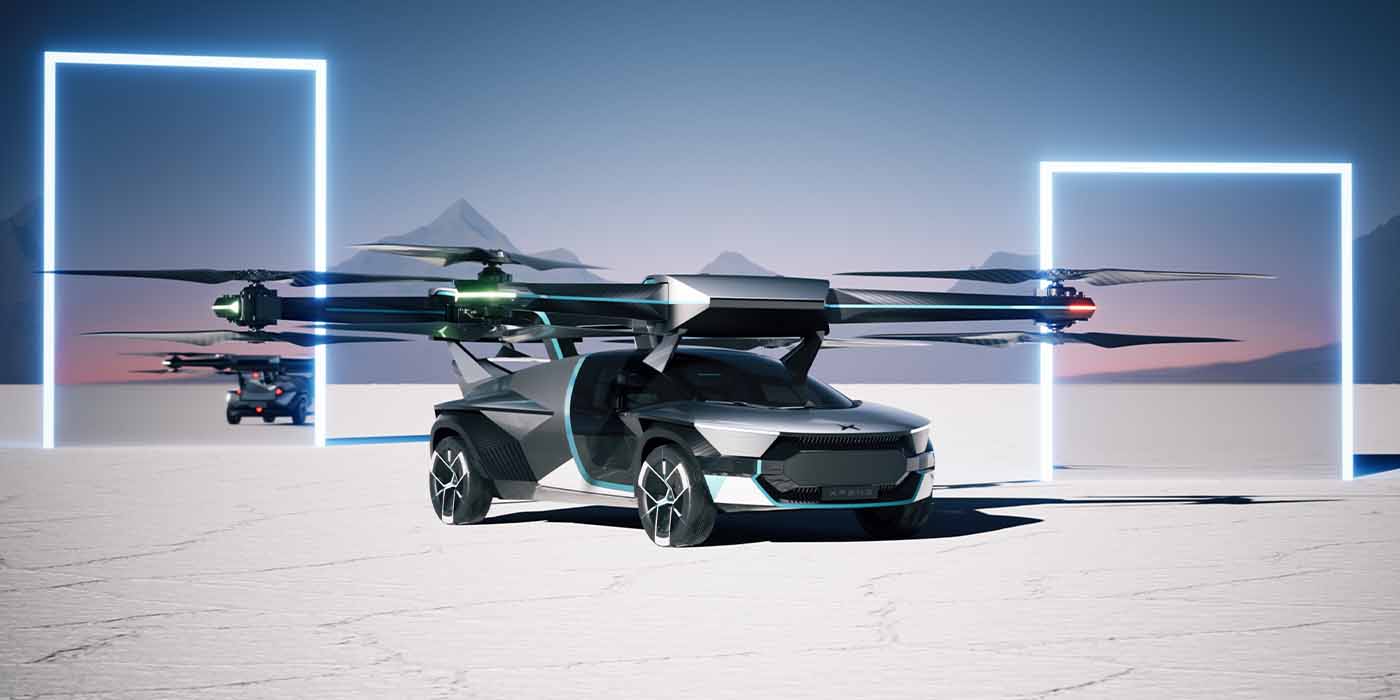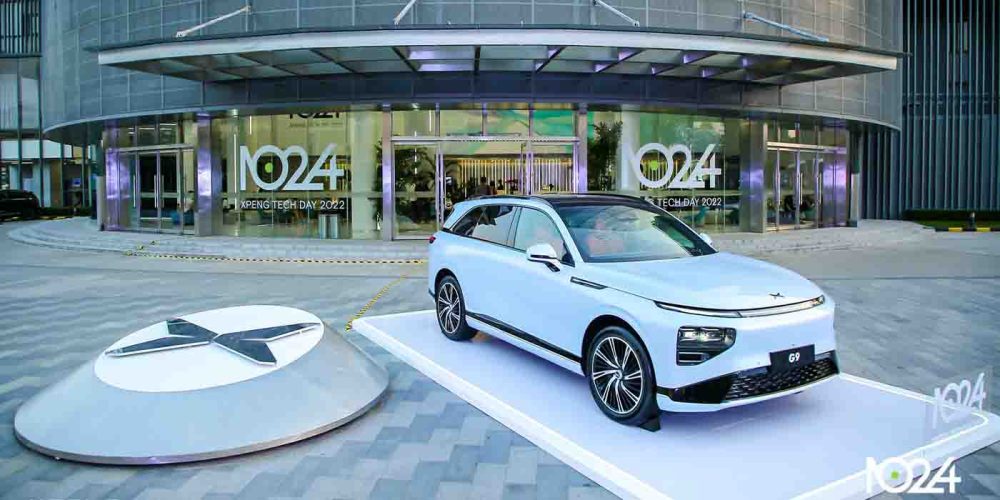
XPeng completed its fourth annual 1024 Tech Day in China today, highlighting several of its latest technological breakthroughs in electric mobility. The presentation included several advancements in autonomous driving, robotic animals, and self-evolving AI platforms. Additionally, XPeng Inc. shared that its sixth generation eVTOL – the closest thing we’ve seen to an actual flying car – completed its maiden flight. Lots to unfold here, so let’s get started.
Table of contents
Quick recap leading up to XPeng’s Tech Day 2022
XPeng Inc. ($XPEV) is a Chinese EV manufacturer founded in 2014 in Guangzhou that is made up of XPeng Motors and XPeng AeroHT, formerly known as XPeng Huitian – which specializes in Urban Air Mobility (UAM).
In addition to manufacturing EVs and electric vertical takeoff and landing (eVTOL) vehicles, XPeng develops its own software and charging products and has begun dipping into other ventures like robotics as well.
During last year’s 1024 Tech Day, XPeng revealed advancements to its XPILOT ADAS, “X Power” superchargers, and a robotic pony prototype equipped with LiDAR. XPeng wrapped last year’s Tech Day with what was probably its coolest announcement: the debut of its sixth generation eVTOL – the first to actually be worthy of the term “flying car.”
Previous versions of its eVTOLs didn’t have wheels but were based around the XPeng’s P7 EV architecture, so the UAM division still used the term “flying car.” However, AeroHT’s latest model can traverse both roads and air and has recently completed its maiden flight. More on that below.

Big upgrades to XPeng’s XNGP ADAS
When it debuted on the automaker’s G9 SUV in September, XNGP (navigation-guided pilot) was announced as XPeng’s last step before achieving fully autonomous driving. XNGP combines all scenarios of the automaker’s existing ADAS capabilities (highway, city, parking) into one holistic system that will soon no longer require high-precision maps to function – essentially opening up its availability to any and all areas.
At Tech Day 2022, XPeng shared that XNGP is backed by major hardware upgrades, including 508 TOPS of computing power, a dual-LiDAR system, 8-megapixel HD cameras, and a new software architecture called XNet, which operates using a closed-loop, self-evolving AI and data system.
XPeng unveils XNet neural network-based architecture at Tech Day
XPeng’s XNet varies from its first-generation visual perception architecture by adopting a deep neural network that was developed in-house to deliver visual recognition with human-like decision-making capabilities, drawing data from multiple cameras.
The company explained that its autonomous driving technical stack can reach 600 PFLOPS, increasing the training efficiency of the autonomous driving model by over 600 times. To that note, model training can be significantly reduced from 276 days to just 11 hours.
For added texture in regard to XNet’s streamlined efficiencies, it now only uses 9% of its Orin-X chip’s processing power, compared with 122% before optimization. These upgrades have enabled XPeng to establish an entirely closed-loop autonomous driving data system (data collection, labeling, training, and deployment) that utilizes lightning-fast machine learning to consistently self-improve. Per the release:
XPeng’s high-efficient AI capabilities enable consistent and unsupervised machine leaning and rapid iterations in training models, resolving over 1,000 rare corner cases each year. This highly efficient closed-loop AI and data system has helped reducing incident rate for the Highway NGP by 95%.
Continuing through the Tech Day presentation, the XPeng team explained that the technology above will help enable the automaker to develop and deploy an autonomous robotaxi fleet in China.

G9 SUV will be part of the XPeng’s robotaxi network in China
On stage at Tech Day 2022 in Guangzhou was XPeng’s vice president of autonomous driving, Dr. Xinzhou Wu, who shared that XPeng is developing a robotaxi network in China. The company shared that the G9 SUV became the country’s first mass-produced commercial vehicle to pass the Autonomous Driving Closed-field Test led by the Chinese government.
By completing the test to operate in a tier-one city like Guangzhou, XPeng states it has taken a major step forward in robotaxi development, all while using existing technology present on its latest EV. Wu elaborated:
Obtaining the road test permit by our mass-produced commercial vehicles – with no retrofit – is a major achievement. Our platform-based robotaxi development aims to generate significant cost benefits, and ensure product quality, safety and user experience.

XPeng’s robotic pet gets an upgrade to support better motion
As you can see from the image above, XPeng’s software is not the only technology that got upgrades since last year’s 1024 Tech Day event. The aforementioned “pony” robot has gotten a revamped design to support multidegree-of-freedom (MDOF) motion and locomotion capabilities. Other upgraded features include the following:
- A more sophisticated mechanical structure
- Higher transmission efficiency
- Stronger robot actuator
- High-end auto-grade computing platform
- Battery and thermal management system
- Significant upgrades to the motion control system
- Robot can better adapt to complex indoor and outdoor terrain conditions like stairs, steep slopes, and gravel roads
The robot 2.0 looks cooler but is still sort of creepy. We’d still take it over a Tesla humanoid bot any day, though. We are looking forward to seeing it in action. Perhaps a battle against Boston Dynamics?

Latest eVTOL gets upgraded design, completes maiden flight
Last, and certainly not least, is the latest eVTOL update from AeroHT. Much like XPeng’s 1024 Tech Day last year, footage of its sixth-generation “flying car” stole the show.
During this year’s event, XPeng unveiled the latest version of the eVTOL, which has been optimized from last year’s horizontal dual-rotor structure to a new distributed multirotor configuration. The company also shared that the overall system design complexity of the eVTOL has been reduced to ensure better safety and reliability during flights.
As previously mentioned, this eVTOL is equipped with wheels and is capable of driving mode in addition to flight mode. XPeng AeroHT explained that driving mode is comparable to any conventional car in terms of functionality and measurement.
In flight mode, however, the eVTOL is piloted using the steering wheel and a right-hand gear lever that controls movement forward and backward, makes turns, ascends, hovers, and descends. AeroHT demonstrated this wheel and lever design in an eVTOL test flight video from July.
In addition to showcasing the upgraded flying car, XPeng also shared that the eVTOL has already completed its maiden flight in addition to multiple single-motor failure tests.
We’re still awaiting that flight footage from XPeng, but for now you can check out the rendering video showcasing the new eVTOL design shared during the Tech Day presentation.
FTC: We use income earning auto affiliate links. More.

Comments